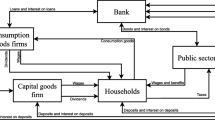Abstract
We develop an agent-based model of labor market regulation to study the consequences of employment protection legislations for labor market performance. Unlike most of the existing studies of labor market regulation we endogenize the institutional setting. Workers cast their vote on labor market regulation depending on the past payoffs that they accrued when one of two competing parties with different labor market policy platforms was in power. We identify important interactions with exogenous shocks. In more turbulent economic times, employment protection systems can affect labor market performance for some periods even after the shock has subsided.
Similar content being viewed by others
References
Baker, D., Glyn, A., Howell, D., & Schmitt, J. (2005). Labor market institutions and unemployment: A critical assessment of the cross-country evidence. In Fighting unemployment—the limits of the free market orthodoxy (pp. 72–113). Oxford University Press.
Belot M., van Ours J. (2004) Does the recent success of some OECD countries in lowering their unemployment rates lie in the clever design of their labor market reforms?. Oxford Economic Papers 56: 621–642
Bertola, G., Blau, F., & Kahn, L. (2002). Comparative analysis of labour market outcomes: Lessons for the U.S. from international long-run evidence. In A. Krueger & R. Solow (Eds.), The roaring nineties: Can full employment be sustained? (pp. 159–218). Russell Sage and Century Foundations.
Bewley T. (1999) Why wages don’t fall during a recession. Harvard University Press, Cambridge, MA
Blanchard O., Portugal P. (2001) What hides behind an unemployment rate: Comparing Portuguese and US labor markets. American Economic Review 90: 187–207
Blanchard O., Wolfers J. (2000) Shocks and institutions and the rise of European unemployment: The aggregate evidence. The Economic Journal 110: 1–33
Elmeskov J., Martin J., Scarpetta S. (1998) Key lessons for labour market reforms: Evidence from OECD countries’ experience. Swedish Economic Policy Review 5: 205–252
Fagiolo G., Dosi G., Gabriele R. (2004) Matching, bargaining, and wage setting in an evolutionary model of labor market and output dynamics. Advances in Complex Systems 7: 157–186
Fowler J., Smirnov O. (2005) Dynamic parties and social turnout: An agent-based model. American Journal of Sociology 110: 1070–1094
Freeman, R. (2005). Labour market institutions without blinders: The debate over flexibility and labour market performance. NBER Working Paper 11286.
Garibaldi P. (1999) Job flow dynamics and firing restrictions. European Economic Review 42: 245–275
Heckman, J., & Pages, C. (2000). The cost of job security regulation: Evidence from Latin American labour markets. NBER Working Paper 7773.
Hümmerich, K. (1999). Die arbeitsgerichtliche Abfindung—Ein Beitrag zur Abfindungspraxis und zur gesetzlichen Neuregelung. Neue Zeitschrift für Arbeitsrecht, 342–358.
Kollman K., Miller J., Page S. (1997) Political institutions and sorting in a Tiebout Model. American Economic Review 87: 977–992
Lazear E. (1990) Job security provisions and unemployment. Quarterly Journal of Economics 55: 699–726
Lindbeck A., Weibull J. (1987) Balanced-budget redistribution as the outcome of political competition. Public Choice 51: 272–297
Martin C., Plümper T. (2005) Number of parties, endogenous partisan preferences, and electoral turnout rates: A stochastic equilibrium analysis. Social Science Computer Review 23: 347–359
Mortensen D., Pissarides C. (1999) Unemployment responses to ‘skill biased’ technology shocks: The role of role of labour market policy. The Economic Journal 109: 242–265
Mueller, D. (2003). Public choice III. Cambridge University Press.
Neugart M. (2004) Endogenous matching functions: An agent-based computational approach. Advances in Complex Systems 7: 187–201
Neugart M. (2008) Labor market policy evaluation with ACE. Journal of Economic Behavior and Organization 67: 418–430
Nickell S. (1997) Unemployment and labour market rigidities: Europe versus North America. Journal of Economic Perspectives 11: 55–74
Nickell S., Nunziata L., Ochel W. (2005) Unemployment in the OECD since the 1960s: What do we know?. The Economic Journal 115: 1–27
OECD. (2004). OECD Employment Outlook.
Oswald A. (1985) The economic theory of trade unions: An introductory survey. Scandinavian Journal of Economics 87: 160–193
Persson, T., & Tabellini, G. (2002). Political economics: Explaining economic policy. MIT Press.
Pingle, M., & Tesfatsion, L. (2003). Evolution of worker-employer networks and behaviors under alternative unemployment benefits: An agent-based computational study. In A. Nagurney (Ed.), Innovations in economic and financial networks (pp. 256–285). Edward Elgar Publishers.
Richiardi M. (2006) Toward a non-equilibrium unemployment theory. Computational Economics 27: 135–160
Tesfatsion L. (2001a) Introduction to the special issue on agent-based computational economics. Computational Economics 18: 1–8
Tesfatsion L. (2001b) Structure, behavior and market power in an evolutionary labor market with adaptive search. Journal of Economic Dynamics and Control 25: 281–293
Tesfatsion, L. (2006). Agent-based computational economics: A constructive approach to economic theory. In K. Judd & L. Tesfatsion (Eds.), Handbook of computational economics (Vol. 2). North-Holland.
Author information
Authors and Affiliations
Corresponding author
Rights and permissions
About this article
Cite this article
Martin, C.W., Neugart, M. Shocks and Endogenous Institutions: An Agent-based Model of Labor Market Performance in Turbulent Times. Comput Econ 33, 31–46 (2009). https://doi.org/10.1007/s10614-008-9149-z
Received:
Accepted:
Published:
Issue Date:
DOI: https://doi.org/10.1007/s10614-008-9149-z




